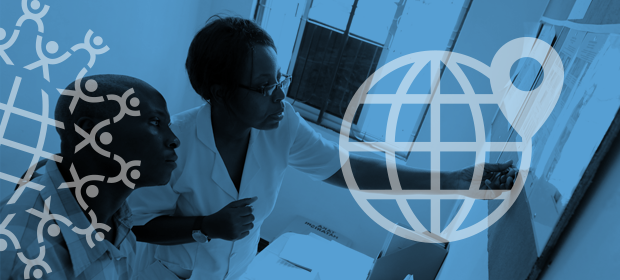Where We Work
See our interactive map



Lessons in localization with global health CEOs Maqsoda Maqsodi and Pape Gaye.
If you ask the head of any international or regional NGO what is on their mind lately, chances are it’s the same thing that’s on ours: the localization debate.
And it truly is a debate—opinions vary on every aspect of it, from what we should call it to how to do it, and how to help your organization survive it. Those of us who follow such things have seen an onslaught of opinion pieces on this topic lately, most of which highlight northern perspectives and the points of view of implementers and donors.
Shifting power is the right thing to do.
It seems there are two things on which we all generally agree: 1) that shifting power and resources to local organizations that know their communities’ needs and contexts best is the right thing to do, and 2) that doing so will fundamentally change our businesses.
Adaptation is not optional. But how?
Many organizations are passively resisting this shift, acquiring one another or creating subsidiaries that call themselves local but are in fact not. Others have long recognized that localizing programs has always been the end game, and so they’ve invested in creating local organizations that eventually become independent entities.
As we embark on adapting our two organizations—IntraHealth International and the Baobab Institute—we are asking ourselves some tough questions. How do we leverage the progress we’ve made as a global community over the last 50 years? How do we safeguard the partnerships and collaborations that have made that progress possible? And what steps must we as NGO leaders take to avoid sustaining the very systems we’re trying to change?
In short, how do we avoid being the colonizers?
As two CEOs who are not white, were not born in the United States, and are leaders of organizations that work to expand access to health care in low- and middle-income countries like the ones in which we were born, we want to share three steps we and other global health leaders can take to build a future of inclusive, locally-led development—and expand our impact at the same time.
So far, the conversation about localization has focused on shifting resources—but it should instead be about shifting power.
To do this, we must hear and listen to more local voices. As NGO leaders, we must do all we can to make sure the local point of view is prominent in conversations where decisions are made, to create safe spaces for representatives of local communities to speak and be heard, and to amplify their messages through our own platforms.
Here are just a few examples of how we’ve seen this done effectively:
As leaders of NGOs, it’s easy to stay in the mindset of the funding organizations with whom we work, most of which have traditionally dictated what, where, and how development work is to be done. It’s a top-down approach that creates systemic power imbalance right off the bat.
But consider how the power would shift if countries conceptualized their own activities, based on their own data and their own understanding of their populations’ needs.
USAID has taken the lead on localization.
Fortunately USAID has taken the lead on localization, come up with a strategy, and begun moving this agenda forward using everything the agency has learned from PEPFAR and other initiatives. One major focus of USAID’s strategy is building the capacity of local NGOs to manage available resources, such as through USAID’s Accelerating Support to Advanced Local Partners project.
This is an essential part of solving the power imbalance—but it’s not enough.
International NGOs must embrace a new mindset. We must be willing to commit to deliberately, effectively transitioning responsibilities to local entities. And we must invest more in the design phase of activities, supporting countries to analyze the available data and use those data to inform how they approach funders.
To make locally led development a reality, international and regional NGOs have a critical role to play. We’re well positioned to advise, provide technical services, and serve as brokers between donors, governments, and their local partners to help get the best out of their investments to generate global public goods.
But to do so, we must:
As we lead our organizations into the future, we must stay focused on the so-what of localization and why we are transforming our business models.
Localization is not about countries working in isolation, but about being part of a global community that has made significant progress in reducing extreme poverty. About building together toward a future of inclusive, locally led development.
A commitment to transforming the current top-down approach is a prerequisite for that future.
It’s not going to happen overnight. But if we dedicate the next 5-10 years to taking these steps, we can all save lives faster—together.
Pape Gaye, founder & CEO of the Baobab Institute, served as president and CEO of IntraHealth during 2004–2020. He is a lifelong champion of local capacity development. Maqsoda Maqsodi is currently president & CEO (interim) of IntraHealth and is leading its transformation agenda while upholding its 43-year legacy of inclusive, effective local partnerships for greater global health.
Get the latest updates from the blog and eNews




